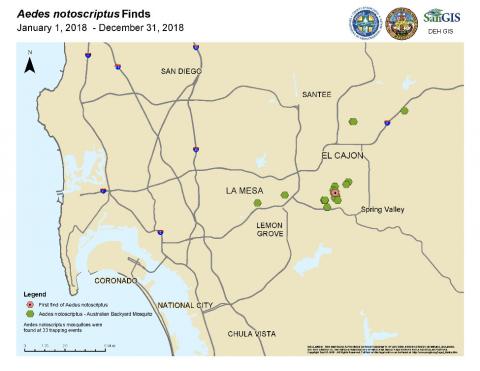
A New Heartworm Vector in San Diego County: Aedes notoscriptus
Anna Kremen, B.S., and Nikos Gurfield, DVM, PhD, DACVP
San Diego County Vector Control
As we enter the peak mosquito season in San Diego County, it is important to learn how to protect ourselves against mosquitoes that can spread diseases. But what about our pets? While we worry about diseases spread by mosquitoes to people, it is also important to pay attention to diseases that can affect our canine companions. One of these diseases is canine heartworm. Although heartworm disease has a low prevalence in canines in San Diego County, there is a new mosquito in town that could potentially increase the risk of transmission.
In May 2018, a new invasive mosquito, Aedes notoscriptus, was discovered in La Mesa. This Aedes mosquito is a competent vector of canine heartworm. Known as the Australian backyard mosquito, Aedes notoscriptus is a common nuisance mosquito found throughout Australia. It was first detected in L.A. County in 2014, in Orange County in 2017 and, most recently, in San Diego County in 2018. Aedes notoscriptusmosquitoes prefer to breed in small sources of water like pet water bowls, rain barrels, potted plant saucers, bromeliads, clogged gutters, landscape drains, birdbaths, fountains, containers or buckets, and even in indoor water sources like flower vases. Their eggs can survive dry for months at a time, which can make them difficult to find and hard to get rid of. Aedes notoscriptus thrives in temperate environments like San Diego where they can stay active through the mild winter months when most other native mosquito activity decreases. These characteristics mean that Aedes notoscriptus has the potential to spread throughout the county. After the initial Aedes notoscriptus detection in La Mesa, the mosquitoes were also detected in El Cajon and Spring Valley (See Figure 1) where they continue to be detected in 2019.
As its common name suggests, these backyard mosquitoes typically breed in urban areas close to people: in backyards, around the neighborhood, and even indoors. This is in contrast to Aedessierrensis, also known as the Western treehole mosquito, which has been the primary mosquito vector for transmitting dog heartworm in California but more commonly lives in rural and suburban environments. Since Aedes notoscriptus mosquitoes prefer to feed on people and animals, they stay close to their preferred food sources. This also makes it easier for them to transmit diseases like canine heartworm. It takes just one filaremic dog combined with a few mosquito vectors to potentially spread the disease to any unprotected dogs in the neighborhood. Heartworm is spread when the mosquito ingests blood from a filaremic dog and then bites another dog, thereby infecting the second dog. The main symptoms of heartworm infection include cough, fatigue, lack of appetite and weight loss. The earlier the heartworm is detected the easier it is to treat, but treatment can be expensive and painful for the dog.
So how concerned about this new mosquito should pet owners be? Canine heartworm has had historically low rates of transmission in San Diego County[1]but the Companion Animal Parasite Council predicts that heartworm rates will be on the rise across the country[2]. Now that Aedes notoscriptusmosquitoes have been detected in the County it is another important reason to prevent the spread of this mosquito and protect canine companions from heartworm. In addition to heartworm prevention medications, one of the best ways to protect dogs from contracting heartworm is to prevent Aedes notoscriptusfrom breeding at home.
Mosquitoes lay their eggs in water and develop through larval and pupal stages in the water before emerging as adults. This lifecycle can be completed in as little as ¼ inch of water and in under one week during warm summer and fall months. The adult flight range is several hundred meters so if Aedes notoscriptus is detected in your backyard, chances are that their breeding source is nearby. Since ¾ of the mosquito’s lifecycle is completed in water, the easiest way to prevent mosquitoes is to eliminate standing water around your home and neighborhood. Checking for standing water and dumping it out at least once a week will interrupt their lifecycle and prevent them from emerging as adults. Some good places to check include rain barrels, potted plant saucers, bromeliads, drains, clogged gutters, birdbaths, fountains, trash, pet water bowls, containers or buckets, children’s toys left outside, and even indoor sources like flower vases. They can breed both outdoors and indoors so make sure that windows are properly screened off. For standing water that cannot be emptied, treat with a bacterial larvicide such as mosquito dunks found online or at some home and garden centers. Bacterial larvicides are specifically targeted to kill mosquito larva and are nontoxic to people, pets, plants, and wildlife. Mosquito fish that eat mosquito larva are another resource that can be used in areas such as ponds or green pools and can be obtained for free from the Vector Control Program.
Please remind staff and clients to follow the County guidelines of “Prevent, Protect, Report.” Prevent mosquito breeding by getting rid of standing water, protect yourself by wearing insect repellent and long sleeves/pants, and report any green pools or high mosquito activity to the County of San Diego Vector Control Program. For more information please visit our webpage at www.sdvector.com or call us at (858) 694-2888.
[1]Companion Animal Parasite Council. Parasite Prevalence Maps. 2019. Retrieved from: https://www.petsandparasites.org/parasite-prevalence-maps/#2019/all/heartworm-canine/dog/united-states/california/223-san-diego-county/
[2]Companion Animal Parasite Council. Press Releases. 2019. Retrieved from: https://www.petsandparasites.org/about-capc/press-releases/companion-animal-parasite-council-annual-forecast-is-released/
